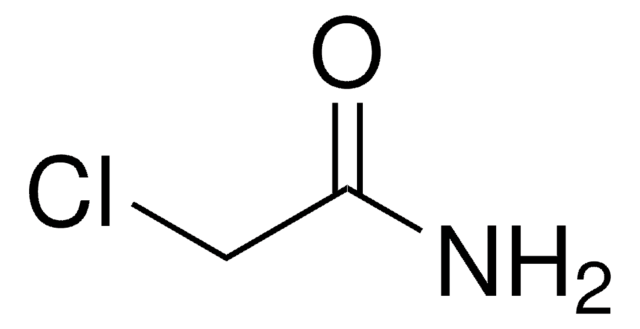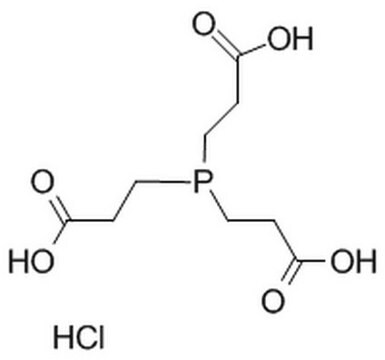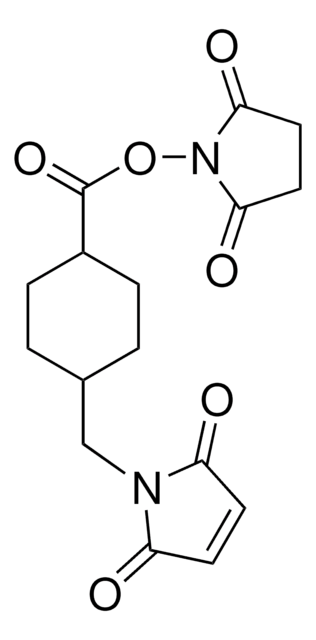68957
Tris(2-carboxyethyl)phosphine hydrochloride
BioUltra, suitable for electrophoresis, SDS-PAGE tested
동의어(들):
TCEP.HCL, TCEP
로그인조직 및 계약 가격 보기
모든 사진(1)
About This Item
실험식(Hill 표기법):
C9H15O6P · HCl
CAS Number:
Molecular Weight:
286.65
Beilstein:
3724376
MDL number:
UNSPSC 코드:
12352128
PubChem Substance ID:
NACRES:
NA.32
추천 제품
제품 라인
BioUltra
분석
97.5-102.5%
형태
powder
기술
electrophoresis: suitable
solubility
H2O: soluble
적합성
SDS-PAGE tested
SMILES string
Cl[H].OC(=O)CCP(CCC(O)=O)CCC(O)=O
InChI
1S/C9H15O6P.ClH/c10-7(11)1-4-16(5-2-8(12)13)6-3-9(14)15;/h1-6H2,(H,10,11)(H,12,13)(H,14,15);1H
InChI key
PBVAJRFEEOIAGW-UHFFFAOYSA-N
유사한 제품을 찾으십니까? 방문 제품 비교 안내
일반 설명
Tris(2-carboxyethyl) phosphine hydrochloride (TCEP.HCL ) is a useful reducing agent for Sulphur and nitrogen-containing compounds. TCEP.HCL and the resultant oxide are water-soluble. TCEP.HCL has electron-rich phosphorus and oxygen atoms to combine with various metals, including Rh, Ir, and Pd. It rapidly complexes with Rh and Ir in dioxane at ambient temperature. It reduces disulfide linkages in a range of peptides and proteins in biological disulfide.
애플리케이션
TCEP.HCL has been used in various bioconjugation applications, both in vitro and in vivo, to tag proteins and live organisms with great effectiveness under mild physiological circumstances. TCEP.HCL is suitable for varied biological and synthetic applications. At an acidic pH, TCEP.HCL can be used to convert organic disulfides to thiols in water irreversibly.
Water soluble reagent, used for selective reduction of disulfides. More stable than DTT and useful in mass spectrometry applications.
특징 및 장점
The product has the following benefits:
- TCEP.HCL lowers reactive oxygen species levels.
- It increases glutathione levels and mitochondrial content.
- It has anti-cancer effects.
분석 메모
agarose gel electrophorese corresponds to requirements
신호어
Danger
유해 및 위험 성명서
Hazard Classifications
Eye Dam. 1 - Skin Corr. 1B
Storage Class Code
8A - Combustible corrosive hazardous materials
WGK
WGK 1
시험 성적서(COA)
제품의 로트/배치 번호를 입력하여 시험 성적서(COA)을 검색하십시오. 로트 및 배치 번호는 제품 라벨에 있는 ‘로트’ 또는 ‘배치’라는 용어 뒤에서 찾을 수 있습니다.
이미 열람한 고객
Siming Chen et al.
Chemical communications (Cambridge, England), 49(12), 1226-1228 (2013-01-05)
A widely used reducing agent tris-(2-carboxyethyl) phosphine significantly promotes the reaction of cisplatin with Sp1 zinc finger protein. This discovery clarifies the reactivity of cisplatin towards Sp1 zinc finger protein and implies that the reactions of platinum drugs could be
Fang-Fang Cheng et al.
The Analyst, 139(16), 3860-3865 (2014-07-01)
The expression of microRNAs (miRNAs) is related to some cancer diseases. Recently, miRNAs have emerged as new candidate diagnostic and prognostic biomarkers for detecting a wide variety of cancers. Due to low levels, short sequences and high sequence homology among
Yan Li et al.
Biosensors & bioelectronics, 67, 364-369 (2014-09-10)
The development of sensitive telomerase biosensors is hindered by the restricted accessibility of telomere strand (TS) primer and the limited enzyme reaction space, which is mainly confined by the vertical distance. In this work, we designed an electrochemical telomerase biosensor
K Zarschler et al.
Nanoscale, 6(11), 6046-6056 (2014-04-30)
For effective localization of functionalized nanoparticles at diseased tissues such as solid tumours or metastases through biorecognition, appropriate targeting vectors directed against selected tumour biomarkers are a key prerequisite. The diversity of such vector molecules ranges from proteins, including antibodies
Nicola J Blackmore et al.
The Journal of biological chemistry, 290(29), 18187-18198 (2015-06-03)
Allostery, where remote ligand binding alters protein function, is essential for the control of metabolism. Here, we have identified a highly sophisticated allosteric response that allows complex control of the pathway for aromatic amino acid biosynthesis in the pathogen Mycobacterium
자사의 과학자팀은 생명 과학, 재료 과학, 화학 합성, 크로마토그래피, 분석 및 기타 많은 영역을 포함한 모든 과학 분야에 경험이 있습니다..
고객지원팀으로 연락바랍니다.








